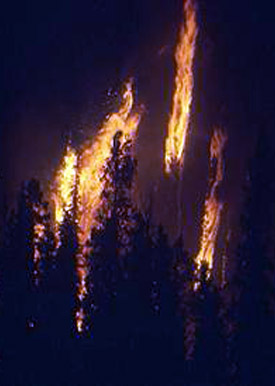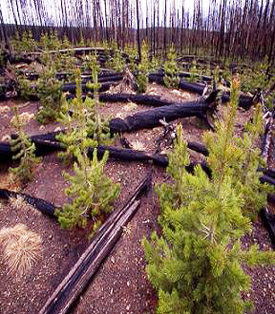
After 20 years, Yellowstone fires recalled
Twenty years have passed since Yellowstone National Park experienced the largest wildfire in its 136-year history.
The wildfires of 1988 burned more than 793,000 acres, equivalent to roughly 36 percent of the park’s 2,221,800 acres. Another 800,000 more acres burned in the Greater Yellowstone Area. The fires began in June after the park suffered the driest summer in its history.
“I guess we were due,” said Robert Barbee, Yellowstone’s superintendent from 1983 through 1995.
 |
Wildfire near the northeast entrance on Sept. 4, 1988 (Photo courtesy of Nancy Clemens, National Park Service). |
Barbee explained that fires started by lightning strikes were the norm throughout that region of the country.
“Fire’s part of the system as sunshine, rain or frost,” he said.
The first few fires in the park were allowed to burn because of the park’s “natural burn” policy. The controversial policy was enacted in 1972 after research showed that fire was beneficial to the park’s ecosystem. Since 1972, naturally started fires are allowed to burn unless they threaten establishments, endangered species or people.
Those first fires were minor until heavy winds blew them into a huge conflagration in mid-July. On July 20, officials decided that all fires were to be actively fought throughout the park. Three of the five largest fires were man-made that weren’t stopped in time.
John Varley, chief of the Division of Research at the time, said that the decision to stop the fires was an agonizing one.
“Whether to let the fire go and do its thing was reconsidered on a daily basis,” he said.
Varley explained that, in order for re-growth to take place, decayed trees must burn to release minerals necessary for new growth. Yellowstone’s lodgepole pines, which make up nearly 80 percent of the trees in the park, are increasingly flammable after they’re 150 years old. The combination of abundant forest fuel, the particularly dry season and very heavy winds caused the park’s forest undergo a major facelift.
Science education professor Dr. Robert J. Ruhf agreed with Varley’s assessment.
| Burned pines and trunks line this forest. Trees will slowly erode and new pines will begin to grow (Photo courtesy of Jim Peaco, National Park Service). |
 |
“I don’t think anything would have stopped the forest fire,” said Ruhf, currently a professor at Western Michigan University who wrote an article titled, “The 1988 Forest Fires of Yellowstone National Park.” http://www.x98ruhf.net/yellowstone/fire.htm
Ruhf explained that the “Smokey the Bear” fire policy, in which all forest fires were extinguished immediately, wasn’t healthy for the forest.
“If you put these fires out, these forests get thicker, thicker and thicker,” he said.
To help prepare for a forest fire, previous measurements and research were taken to help the park create fire maps that would predict where the fire would go next.
“You could predict what direction fire was going from measurements of fine fuels, medium fuels and heavy fuels,” said Varley. Fine fuels are categorized as grass and leaves, medium fuels as branches, and heavy fuels as large tree logs.
He added that the 1988 wildfires had the researchers “seeing behavior not been observed in 16 years.”
“I’ve never seen fire behavior like we’re seeing now,” he said at the time. Varley also explained that the ecosystem’s adaptations allowed for fires to become more beneficial.
Lodgepole pines, for example, benefit from fires because of their two types of pine cones. The first type is a regular pine cone, one that it falls to the ground and releases its seeds. The second type explodes when heated by a fire, shooting its seeds throughout the area.
 |
A lodgepole pine cone that exploded after it was heated (Photo courtesy of Jim Peaco, National Park Service). |
“Something evolved in that species to take into account that fire would sweep through the forests,” Varley said. Lodgepole pines are also very fire resistant in their first 150 years of life, but very flammable after 150 years of age.
Other plants that have adapted to frequent fires are sagebrush, a type of grass found throughout the park. Research found that fire stimulates the sagebrush’s seeds to germinate.
The ecosystem’s ability to adapt to numerous wildfires helped quicken its recovery. In certain parts of the park, nearly 50 percent of the burned areas were undergoing new growth the very next year.
“The bounce back was almost immediate,” Barbee said.
Varley agreed with Barbee.
“On a landscape scale, the park has grown back,” said Varley.
Fire prevention efforts also aided in the quick re-growth of the park.
Dan Sholly, chief ranger at Yellowstone from 1985 until 1988, headed the firefighting effort that involved over 25,000 firefighters from throughout the country. He explained that the first priority was avoiding “some of the damages that could occur from suppressing the fire.”
At the effort’s peak in early September, more than 9,000 firefighters were deployed at Yellowstone. Sholly said that the hardest part of the effort was educating the firefighters that, for example, grizzly bears, an endangered species at the time, took precedence over the fire suppression.
| Firefighters work to extinguish fires throughout the brush meadow (Photo courtesy of Jim Peaco, National Park Service). |
 |
“The hardest part was educating people who came from other places trying to understand the fire behavior,” he said.
Added pressure on Yellowstone came from the news media. National media labeled the “natural burn” policy the “let it burn policy.”
Conrad Smith, an assistant professor of journalism at Ohio State University in 1988, did several studies about the media’s interpretation of the fires.
“Reporters came in thinking of it as an urban fire,” Smith, now a professor at the University of Wyoming, said.
Smith noted that, although several reports were inaccurate and misleading, the root of the problem was the knowledge of the reporters sent to Yellowstone in 1988.
“General assignment reporters didn’t have background to cover the story,” he said. He explained that the media “didn’t understand it’s not a static park.”
Smith also explained that Yellowstone’s public relations department wasn’t equipped to handle the amount of coverage given to the fires.
“The culture doesn’t encourage action between journalists and people covering land,” he said.
Barbee agreed, explaining that with little things going on in the summer of 1988, the media “went crazy” with the story.
 |
New lodgepole pine trees grow among dead pines (Photo courtesy of Jim Peaco, National Park Service) |
“They generally tried to characterize things with high drama and hyperbole,” he said.
In addition, Sholly said that, despite the heavy backlash, the decisions were made for the good of the park.
“We had a lot of pressure on us but we knew it was the right thing for Yellowstone,” he said.
But could a fire of this magnitude happen again? Although unwilling to say never, Ruhf said it was “unlikely.”
“The likelihood is less because you have so much of the forest that is burned out,” said Ruhf.
Ruhf noted that centuries have passed in-between major wildfires in the area. He explained that specific conditions contributed to the wildfires in 1988. He also said that the “patchiness” of the burned areas would condense fires to specifics parts of the forest.
“You don’t have continuous forest like you did before,” he said.

Comments are Closed